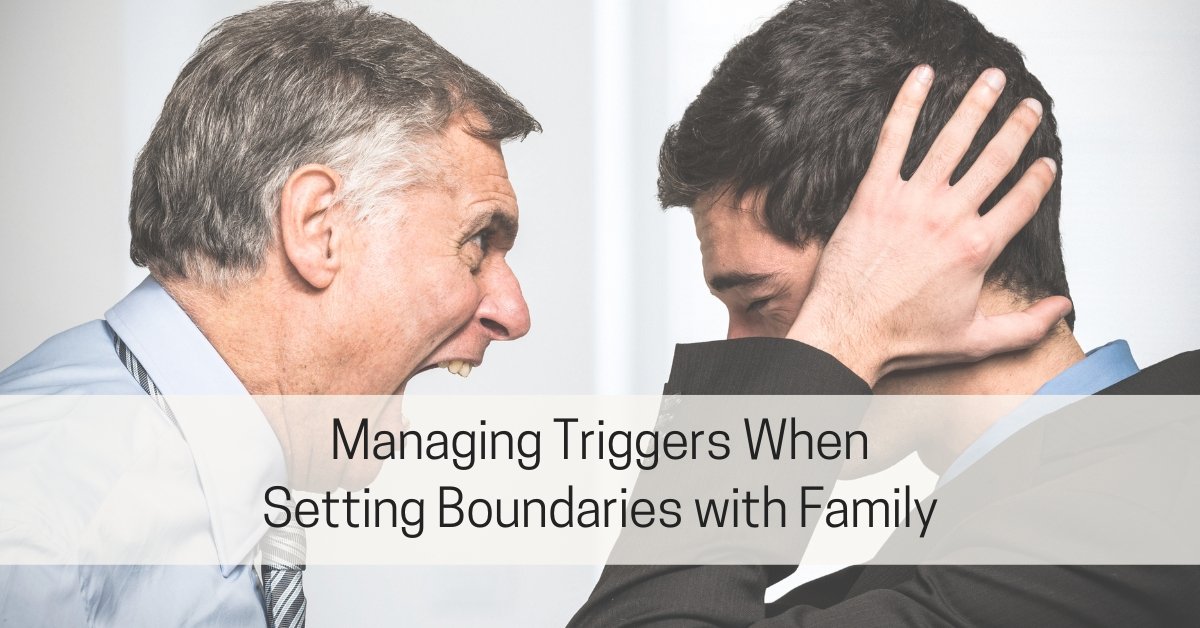Setting boundaries with your family can stir up old emotional wounds. Learning to manage your triggers will help you set more effective boundaries.
What are Boundaries and Why Are They Important?
Boundaries are the invisible lines we draw to define what’s acceptable and unacceptable behavior. They encompass how much of ourselves we share emotionally and physically, how much time we dedicate to others, and how we expect to be treated. Healthy boundaries create a safe space for us to thrive. They allow us to maintain our sense of self, build trust, and foster healthy, fulfilling relationships.
Boundaries can be difficult to set and maintain, but they’re essential in all relationships. For example, imagine a garden without a fence. Weeds would quickly take over. Bunnies and deer would gobble up your plants. Boundaries are like the fence, protecting our emotional well-being and allowing healthy connections to bloom. Without them, we’re susceptible to susceptible to mistreatment, manipulation, resentment, and exhaustion.
Why Setting Boundaries with Family Can Be Triggering
Emotional triggers are internal or external cues that remind you of traumatic experiences. They are natural and common responses but left unchecked, they can derail your efforts to set needed boundaries.
A specific tone of voice, a hot-button issue, or even a smirk or eye roll can transport us back to a time when we felt unsafe, unheard, or unloved by our families. When setting boundaries with your family of origin these triggers can be particularly strong.
Setting boundaries with family can be particularly triggering for these reasons:
Family History: Your family of origin shapes your understanding of relationships and intimacy. If our upbringing involved criticism, guilt trips, or emotional manipulation, setting boundaries can challenging, as it may disrupt the familiar dynamic and evoke fears of rejection or conflict.
Enmeshment: In some families, boundaries are blurred or non-existent. There might be an unhealthy level of emotional dependence, where personal space and individuality are sacrificed for the sake of “family unity.” Setting boundaries in an enmeshed family can feel like you’re severing a vital connection and being disloyal.
Guilt and Obligation: We’re often conditioned to believe that family relationships supersede personal needs. Setting boundaries can induce feelings of guilt and a sense of obligation to prioritize your family over yourself, even if doing so is detrimental to your well-being.
Common Triggers When Setting Boundaries with Family
The situations, people, and behaviors that you find triggering are unique to you. I encourage you to use the following list to identify your specific triggers and make a note of them.
- Bringing Up the Past: Discussions about past hurts or conflicts can be emotionally charged, especially if they haven’t been fully resolved. Trying to establish boundaries around these topics might trigger a resurgence of old wounds.
- Invalidation: An eye roll or comment like, “No one cares what you think” can remind you of times when your family disregarded your feelings or needs. Read more: When Someone Invalidates Your Feelings.
- Guilt Trips: Some families rely on guilt to manipulate family members. Hearing phrases like, “After all we’ve done for you,” can trigger a sense of obligation and make it difficult to say no.
- Overstepping Boundaries: If a family member has a history of disregarding your personal space or privacy, attempts to set boundaries around these issues might trigger a power struggle.
- Unrealistic Expectations: Families often have unspoken expectations about how members should behave. Attempting to break free from these expectations can trigger feelings of disappointment or disapproval.
- Criticism: If you were frequently criticized as a child, hearing any form of critique now, even constructive criticism, might trigger feelings of shame or inadequacy.
- Rejection: Having your boundaries disregarded can feel like a personal rejection. It can reactivate fears of being rejected or disowned by your family.
Strategies for Managing Emotional Triggers
What can we do when emotional triggers threaten to derail our boundary-setting efforts? Here are some strategies to help you navigate these challenging situations.
1. Self-Awareness.
The first step is to identify your triggers. When you’re triggered you may over or underreact. That is, your emotions may seem stronger than what the situation warrants. Intense feelings of anger, shame, fear, or overwhelm can be signs that you’re not just reacting to what’s happening now—you’re also responding to past wounds.
Underreacting is not as obvious because it’s not observable; it’s a lack of response when something actually warrants one. When you underreact, you push your feelings down and internalize them rather than express them. Pretending something doesn’t bother you—when it does—is an underreaction. As is, not speaking up when someone offends you.
In addition, notice physical sensations like a racing heart, sweaty palms, or tightness in your chest. These are often indicators that a trigger has been activated.
Journaling after an overreaction, underreaction, or physical sensation can help you identify patterns and bring greater awareness to specific triggers.
2. Take a Break.
Step away from the triggering situation and allow yourself to cool off and process your thoughts and feelings. Deep breathing exercises, progressive muscle relaxation, and mindfulness meditation can all help calm your nervous system and mitigate the physical effects of emotional triggers.
3. Validate Your Emotions.
Don’t dismiss your emotions as “overreacting.” Instead, say, “I’m feeling overwhelmed right now.” This allows you to take a step back and respond thoughtfully rather than reacting to the trigger.
Read more: 17 Ways to Validate Yourself.
4. Release Physical Tension.
Emotions and stress live in our bodies and we need to physically release them. Find a physical activity that you enjoy to help move stress hormones and difficult emotions out of your body. A vigorous activity such as dancing, running, jumping jacks, or riding a bike can help. You can also try physically soothing activities such as soaking in a hot bath, a massage, or stretching.
5. Use Your Support System.
Having a trusted friend, therapist, or support group can provide a safe space to process your emotions and strategize boundary setting.
6. Prepare Your Responses.
Anticipate potential triggers and rehearse what you’ll say. For example, if a family member uses guilt to manipulate you, have a clear response ready, like, “I understand you’re disappointed, but I need to prioritize my well-being.”
7. Communicate Your Needs.
Clear and direct communication is crucial. Explain your boundaries calmly and assertively. You can say, “I love you, but I need some space in this situation.” Focus on “I” statements to avoid accusatory language.
8. Set Realistic Expectations.
Change takes time, especially in long-standing family dynamics. Don’t expect immediate acceptance or agreement. Be prepared to enforce your boundaries consistently, even if it means limiting contact for a while. Remember, your well-being is paramount.
9. Be Kind to Yourself.
Setting boundaries is a challenging but necessary process. There might be setbacks, and that’s okay. Celebrate your successes, learn from your experiences, and extend compassion to yourself.
Setting boundaries with family is an attempt to create a healthier dynamic where everyone can thrive. By managing triggers and communicating effectively, you can establish boundaries that foster respect, understanding, and more authentic relationships with your family.
©2024 Dr. Sharon Martin, LCSW. All rights reserved. Photos courtesy of Canva.com.
Publisher: Source link






